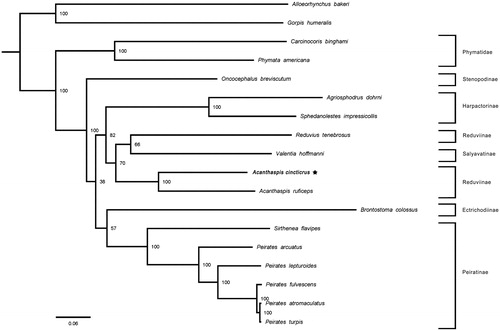Abstract
The complete mitochondrial genome (mitogenome) of Acanthaspis cincticrus is described in this study. The sequenced mitogenome is a typical circular DNA molecule of 15,686 bp, containing 13 protein-coding genes, 2 rRNA genes, 22 tRNA genes and a control region. All protein-coding genes initiate with ATN as the start codon and terminate with TAA codons, except COIII, ND3 and ND5 use a single T residue as the termination codon. Secondary structures of all tRNAs were predicted. The monophyly of the subfamily Reduviinae is not supported by maximum-likelihood phylogenetic tree.
Acanthaspis Amyot and Serville is the second largest genus in Reduviinae which includes about 110 valid species, and nearly two-third of them are distributed in the Oriental region, others in the Ethiopian (Cao et al. Citation2014). Nymphs of the assassin bug A. cincticrus have camouflaging behavior, which can cover themselves with corpses of ants, dust or soil particles above abdomen (Kou et al. Citation2017).
Total genomic DNA was extracted from the thorax of adult collected from Yu country in Hebei province, China. Voucher specimen (No. VCim-00105) was deposited at the Entomological Museum of China Agricultural University (CAU). The complete mitogenome was obtained by next-generation sequencing method with Illumina Hiseq 2500 and the sequence was deposited in GenBank under the accession number KY069958.
This mitogenome is 15,686bp long, including 37 genes (13 protein-coding genes, 22 tRNA genes, and 2 rRNA genes) and a control region. Gene order is identical to the putative ancestral arrangement of insects and other assassin bugs (Zhao et al. Citation2015; Li et al. Citation2017). Except for the control region, the present mitogenome has 10 inter-genic regions, ranging from 1 to 20 bp in size. There are totally 61 bp overlapped nucleotides between neighboring genes in 15 locations, ranging from 1 to 14 bp in size.
The nucleotide composition of the whole mitogenome is significantly biased toward A+T(72.0%)with positive AT-skew (0.14) and negative GC-skew (−0.19). All protein-coding genes initiate with ATN as the start codon (1 with ATC, 2 with ATT, 5 with ATG and 5 with ATA). The stop codon TAA was assigned to 10 protein-coding genes. COIII, ND3, and ND5 used a single T residue as incomplete stop codon which is commonly reported in true bug mitogenomes (Li et al. Citation2012; Song et al. Citation2016). All tRNA genes can be folded into the typical clover-leaf secondary structure, with the exception of tRNASer(AGN), which lack the dihydrouridine (DHU) arm, similar to the case with some other insects (Li et al. Citation2012; Jiang et al. Citation2016).
The length of tRNA gene ranges from 61 to 70 bp. The lrRNA is 1,243bp long with an A+T content of 76.2%, and the srRNA is 775 bp long with an A+T content of 71.4%. The control region located between srRNA and tRNAIle is 1,231 bp long and is also biased towards A+T (67.9%).
Phylogenetic tree was constructed by maximum-likelihood (ML) analysis based on the sequences of the 13 protein-coding genes and 2 rRNA genes from 18 species in Reduviidae (). The sister relationship between A. cincticrus and A. ruficeps is highly supported with the highest bootstrap support value, i.e. 100%. However, the monophyly of the subfamily Reduviinae was not supported, which is similar to the results of previous studies (Weirauch and Munro Citation2009; Hwang and Weirauch Citation2012; Liu et al. Citation2018).
Figure 1. Phylogenetic relationship of 18 assassin bugs inferred from ML analysis of the 13 protein-coding genes and two rRNAs genes (12,697bp). Phylogenetic tree was generated from maximum likelihood analysis by IQ-TREE 1.6.5 (Trifinopoulos et al. Citation2016), under the GTR + I + G model. The nodal values indicate the bootstrap percentages obtained with 1000 replicates.

Disclosure statement
No potential conflict of interest was reported by the authors.
Additional information
Funding
References
- Cao LM, Redei D, Li H, Cai WZ. 2014. Revision of the genus Acanthaspis Amyot & Serville (Hemiptera: Heteroptera: Reduviidae: Reduviinae) from China, with new records of species to adjacent countries. Zootaxa. 3892:1–66.
- Hwang WS, Weirauch C. 2012. Evolutionary history of assassin bugs (Insecta: Hemiptera: Reduviidae): insights from divergence dating and ancestral state reconstruction. PLoS One. 7:e45523
- Jiang P, Li H, Song F, Cai Y, Wang JY, Liu J, Cai WZ. 2016. Duplication and remolding of tRNA genes in the mitochondrial genome of Reduvius tenebrosus (Hemiptera: Reduviidae). IJMS. 17:951.
- Kou F, Li H, Li S, Xun H, Zhang Y, Sun Z, Zhou X, Cai W. 2017. Temporal transcriptomic profiling of the ant-feeding assassin bug Acanthaspis cincticrus reveals a biased expression of genes associated with predation in nymphs. Sci Rep. 7:12691
- Li H, Leavengood JM, Jr., Chapman EG, Burkhardt D, Song F, Jiang P, Liu J, Zhou X, Cai WZ. 2017. Mitochondrial phylogenomics of Hemiptera reveals adaptive innovations driving the diversification of true bugs. Proc R Soc B. 284:20171223.
- Li H, Liu HY, Song F, Shi AM, Zhou XG, Cai W. 2012. Comparative mitogenomic analysis of damsel bugs representing three tribes in the family Nabidae (Insecta: Hemiptera). PLoS One. 7:e45925.
- Liu YQ, Song F, Jiang P, Wilson JJ, Cai WZ, Li H. 2018. Compositional heterogeneity in true bug mitochondrial phylogenomics. Mol Phylogenet Evol. 118:135–144.
- Song F, Li H, Shao R, Shi A, Bai X, Zheng X, Heiss E, Cai WZ. 2016. Rearrangement of mitochondrial tRNA genes in flat bugs (Hemiptera: Aradidae). Sci Rep. 6:25725.
- Trifinopoulos J, Nguyen LT, Haeseler AV, Minh BQ. 2016. W-IQ-TREE: a fast online phylogenetic tool for maximum likelihood analysis. Nucleic Acids Res. 44:W232–W235.
- Weirauch C, Munro JB. 2009. Molecular phylogeny of the assassin bugs (Hemiptera: Reduviidae), based on mitochondrial and nuclear ribosomal genes. Mol Phylogenet Evol. 53:287–299.
- Zhao GY, Li H, Zhao P, Cai WZ. 2015. Comparative mitogenomics of the assassin bug genus Peirates (Hemiptera: Reduviidae: Peiratinae) reveal conserved mitochondrial genome organization of P. atromaculatus, P. fulvescens and P. turpis. PLoS One. 10:e0117862.
